Halfway through December, Mumbai finally has a milder sun and lower humidity levels, making the weather ideal for seasonal flowers. We took a walk through public nurseries and institutions to see what's blooming in their gardens
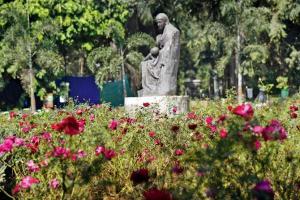
In the tropical city of Mumbai, winter doesn't make a grand entry with gusty winds or the sun playing truant. It sneaks in stealthily when one day, you look out of the office window and realise it's inky dark already. When wrapping your favourite stole around the neck doesn't make you perspire any more. Or when you drive past the divider on your usual route only to find it transformed into a bower of petunias.
ADVERTISEMENT

(Top and above) The rose circle at the Byculla zoo, flaunting floribunda and miniature varieties
Its humidity ideal for leafy ornamental plants, the city's balmy winter with lower moisture levels paves the way for myriad seasonal blooms. But before they are ready to adorn the medians, traffic islands, gardens and other public spaces, they remain under the watchful eye of horticulturalists and gardeners in the small and big nurseries across the 24 municipal wards in the city. December being the transient month with many varieties already transplanted in public spaces, while others still being tended to in nurseries, we found it to be the perfect time to speak to experts to know what it takes to dress Mumbai in its wintry garb.
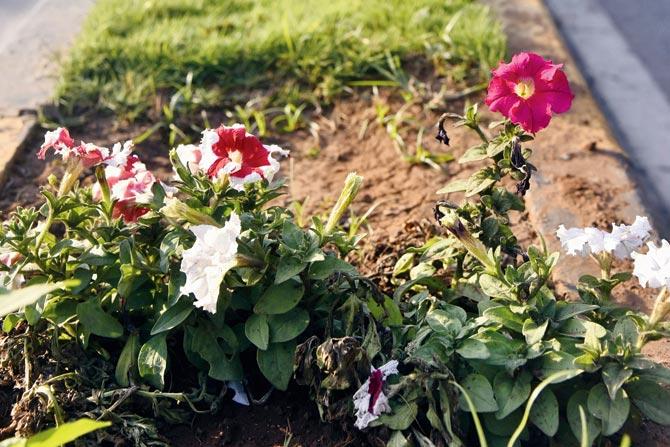
The divider facing the Mantralaya has petunias (in pic) and dianthus in full bloom

Flower saplings get tended to at the nursery in Byculla
"The preparations for the floral beautification of the city begin in October when our team surveys the markets in Mumbai and Pune to source seeds for seasonal flowers such as phlox, asters, salvias, dianthus, pansies, zinnias and petunias. We also look for hybrid and miniature varieties every year," informs a horticulture expert from MCGM, while taking us through the Veermata Jijabai Udyan nursery in Byculla. She adds that the seeds are then sown in trays to initiate the crucial sapling stage.
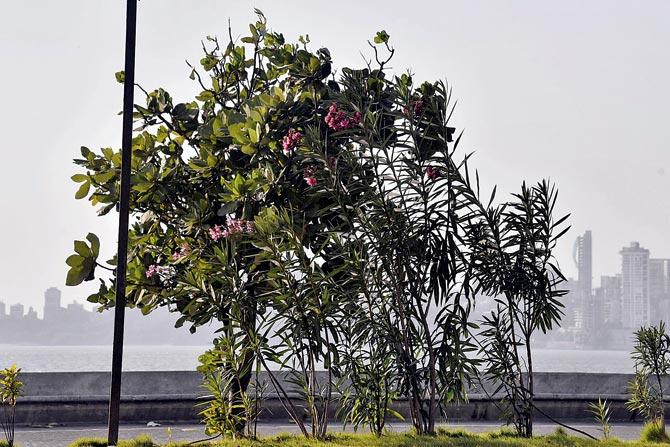
The divider facing the Air India building on Marine Drive displays kaner shrubs flowering on stretches of carpet lawn
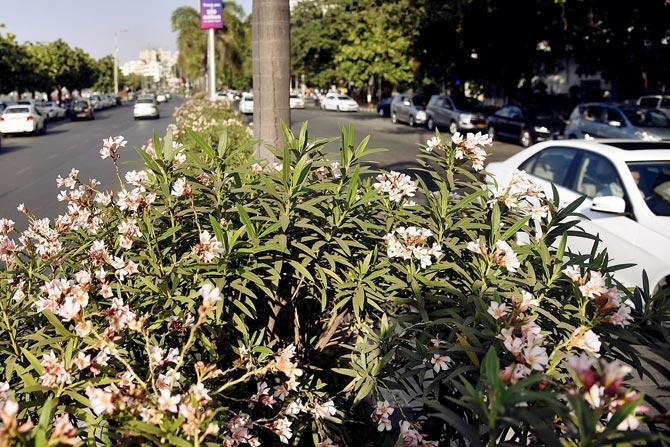
Kaner flowers. Pics/Pradeep Dhivar
"One needs to take utmost care of the saplings, ensuring that the soil is well-drained and the exposure to sunlight is just right. Once they reach the four-leaf stage, manure which includes urea in liquid form is added to facilitate vegetative growth. At the bud stage, we add small doses of suphala [fertiliser], which helps bring out vibrant colours," she explains.
The horticulturalist points out that not all varieties lend themselves to the same use. "You need hardy plants like canna or trailing flowers like petunias for dividers. With Metro work underway, and people climbing atop medians to cross the road, we can't always beautify as many dividers as we would like to," she admits. For sprawling public gardens that offer stretches of unobstructed sunlight - the key ingredient for winter blooms - zinnias and salvias are the top picks.
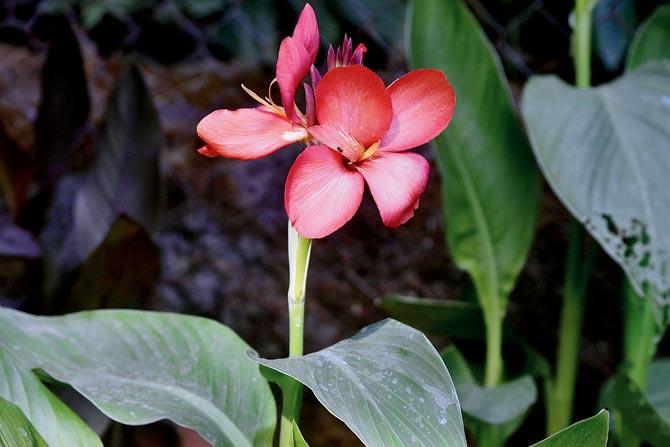
An uncommon colour of canna, usually seen in yellows and reds, has been added to Veermata Jijabai Udyan nursery collection this year
Even for rose plants that continue to flower beyond winter months, this time of the year is most suited for a healthy, bushy appearance. It's evident in the rose circle at the Byculla zoo, where floribundas and miniature rose varieties have swathed the garden in glorious pinks. Over 15 km to the north, the rose garden in the Kalina campus of the University of Mumbai has been recently given a trim to prep it for January, when the garden is in full bloom. Rajappa S Gadgula, who has been nurturing the gardens in the sprawling campus for 14 years, tells us, "Rose plants need a regular feed of cow dung manure. It's best to follow a cycle where the manure is mixed with water and left to ferment for two weeks. On the 15th day, pour it on the soil, and repeat the process. It's also important to remove all wilted flowers regularly," he explains.
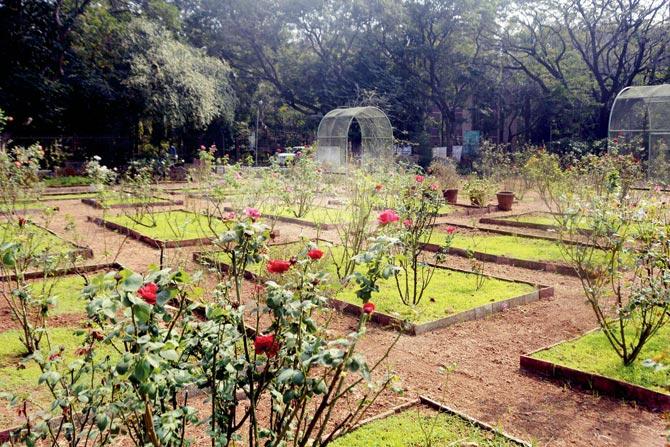
The rose garden at the campus. Pics/Sneha Kharabe
While the conditions may not be possible to replicate in Mumbai homes, where balconies and box grills receive sunlight for a limited time of the day, Satish Yashwant Dalvi, retired garden superintendent of the university, says, "Marigolds and their miniature varieties are good options for domestic gardening in the city."
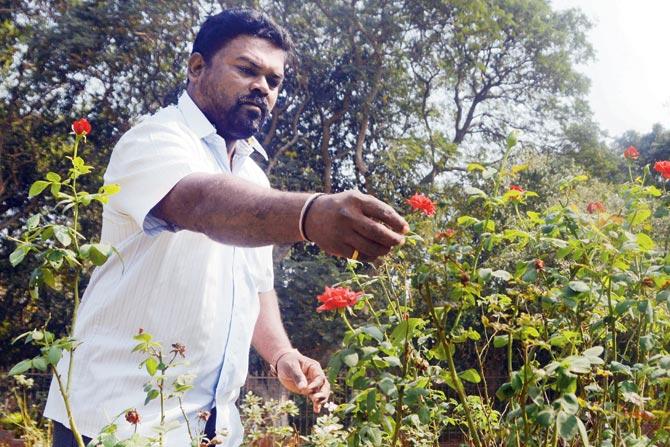
Rajappa S Gadgula has been tending to the gardens at Mumbai university's Kalina campus for 14 years
Seasonal flowers, like Mumbai's transient winter, last only until the first week of March. Then, the perennial varieties make a comeback in all their green glory. As the MCGM expert tells us, "Every plant is special. What's important is you treat it like a living being and cherish its unique beauty."
Catch up on all the latest Mumbai news, crime news, current affairs, and also a complete guide on Mumbai from food to things to do and events across the city here. Also download the new mid-day Android and iOS apps to get latest updates
 Subscribe today by clicking the link and stay updated with the latest news!" Click here!
Subscribe today by clicking the link and stay updated with the latest news!" Click here!






